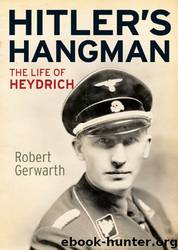Hitler's Hangman: The Life of Heydrich by Robert Gerwarth

Author:Robert Gerwarth
Language: eng
Format: mobi, epub
Tags: Europe, World War II, 20th century, Modern, Germany, Biography & Autobiography, Military, History
ISBN: 9780300115758
Publisher: Yale University Press
Published: 2011-11-15T00:00:00+00:00
CHAPTER VIII
Reich Protector
The Protectorate of Bohemia and Moravia
OF THE NUMEROUS TERRITORIES OCCUPIED AND ADMINISTERED BY NAZI Germany over the course of the Second World War, the Protectorate of Bohemia and Moravia was one of the more curious. With a size of roughly 49,000 square kilometres and an overall population of 7.5 million inhabitants (245,000 of whom were ethnic Germans), the Protectorate was by no means the largest of the Nazi-occupied territories. However, it played a special role in occupied Europe, both because the Nazis perceived Bohemia and Moravia as an integral part of the future Greater German Reich, and because of its crucial geo-strategic location and economic importance for Germany's war effort.1
Established on 16 March 1939, the day after the German occupation of the western half of Czechoslovakia, the Protectorate was to become a German colony presided over by an appointed Reich Protector, a viceroy directly responsible to Hitler. Yet while the colonial rhetoric employed by leading Nazis in order to describe the future of the Protectorate was striking, it concealed more than it revealed: the new constitutional structure imposed on the country was merely a wartime solution which would eventually give way to the full political, economic and racial integration of Bohemia and Moravia into the Greater German Reich. After Germany's victory in the Second World War, the Czechs would either become Germans or they would have to disappear in one way or another.2
For the time being, however, the Czech inhabitants of the Protectorate retained their own autonomous government (at least in theory), while the Sudeten Germans were granted full citizenship of the Reich. All democratic remnants of the Czechoslovak Republic, including the parliament, were abolished. Existing political parties were dissolved and reorganized under the umbrella of the so-called National Solidarity Movement. All that remained of the once thriving democratic system was a nominal Czech administration, headed by Emil Hácha as president, with an appointed fifty-member Committee of National Solidarity chaired by Prime Minister Alois Eliáš. Some 400,000 Czech state employees and civil servants remained in their posts after 1939, alongside, or rather subordinate to, some 11,000 German civilian administrators. This peculiar form of administration imposed on the Protectorate differed significantly from those introduced elsewhere in Nazi-occupied Europe and it reflected the Nazi leadership's recognition that the Protectorate's advanced economy was too precious to be upset by a brutal occupation regime of the sort inflicted on Poland, Belorussia and Ukraine.3
With a major armaments industry in Brünn (Brno) and other Protectorate cities, including one of Europe's leading arms manufacturers, the Škoda works in Pilsen (Plzen), as well as a large number of skilled labourers, the Protectorate's importance for Hitler's war is difficult to overestimate. From the beginning of the occupation, German special units had seized huge quantities of military equipment, arms and ammunition, and Jewish assets were transferred to the German authorities.4 Native industry, however, was left to get on with things under nominal German direction. Czech-owned international companies such as the Bata shoe empire brought in valuable profits and high tax returns, and were not seriously restricted by the German occupiers.
Download
Hitler's Hangman: The Life of Heydrich by Robert Gerwarth.epub
This site does not store any files on its server. We only index and link to content provided by other sites. Please contact the content providers to delete copyright contents if any and email us, we'll remove relevant links or contents immediately.
Fanny Burney by Claire Harman(26506)
Empire of the Sikhs by Patwant Singh(22958)
Out of India by Michael Foss(16776)
Leonardo da Vinci by Walter Isaacson(13140)
Small Great Things by Jodi Picoult(6950)
The Six Wives Of Henry VIII (WOMEN IN HISTORY) by Fraser Antonia(5379)
The Wind in My Hair by Masih Alinejad(5022)
A Higher Loyalty: Truth, Lies, and Leadership by James Comey(4820)
The Lonely City by Olivia Laing(4730)
The Crown by Robert Lacey(4709)
Millionaire: The Philanderer, Gambler, and Duelist Who Invented Modern Finance by Janet Gleeson(4350)
The Iron Duke by The Iron Duke(4269)
Papillon (English) by Henri Charrière(4174)
Sticky Fingers by Joe Hagan(4083)
Joan of Arc by Mary Gordon(4000)
Alive: The Story of the Andes Survivors by Piers Paul Read(3953)
Stalin by Stephen Kotkin(3862)
Aleister Crowley: The Biography by Tobias Churton(3570)
Ants Among Elephants by Sujatha Gidla(3399)
